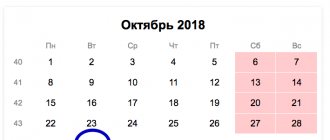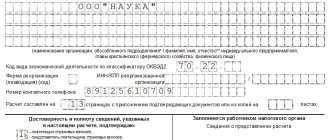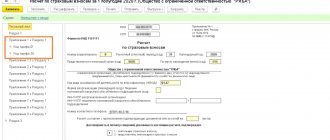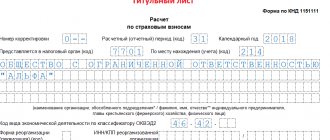What kind of report?
Previously, you submitted RSV-1 and 4-FSS reports to the pension fund and social security.
Insurance premiums for employees were also transferred there. Since 2017, contributions have been paid to the tax office, so a new form of reporting on them has appeared. The report must be submitted to the same tax office where you pay contributions - at the registration of an individual entrepreneur or the legal address of an LLC. The report form was approved by order of the Federal Tax Service
The report partially combines the previous forms RSV-1 and 4-FSS. It contains information about your employees, as well as the fees you have to pay for them. But unlike RSV-1 and 4-FSS, paid contributions do not need to be reflected in the report. The report does not include contributions for injuries, because they still need to be paid to the Social Insurance Fund.
There is now no need to submit the RSV-1 report, and in the 4-FSS report only information about contributions for “injuries” remains.
What will be the calculation of insurance premiums in 2021: a new form and rules for filling it out
Publication date: 12/05/2016 12:30 (archive)
Order of the Federal Tax Service dated October 10, 2016 No. ММВ-7-11/ [email protected] approved the form for calculating insurance premiums, which will be used starting in 2021. The new calculation will replace the forms RSV-1, RSV-2, RV-3 and the current form 4-FSS.
Introductory information
The appearance of the new form is due to the fact that starting next year, the calculation and payment of contributions (except for contributions for injuries) will be supervised by the Federal Tax Service. In this regard, instead of calculations using forms RSV-1, RSV-2, RV-3 and 4-FSS, which are currently submitted to the funds, the policyholder will have to submit one calculation using the new form. It will be accepted by the Federal Tax Service, that is, the tax office.
Please note: reporting to funds will not be completely eliminated next year. Policyholders will have to submit to the Pension Fund a monthly form SZV-M and a new annual report on experience (its form has not yet been approved).
It is necessary to submit calculations for contributions “for injuries” to the social insurance fund using the updated form 4-FSS.
Deadlines and method for submitting a new contribution calculation
A new calculation must be submitted once a quarter, no later than the 30th day of the month following the reporting (calculation) period. This is stated in paragraph 7 of Article 431 of the Tax Code of the Russian Federation (will come into force next year).
Thus, in 2021, the deadline for submitting a new calculation for the first quarter will be on May 2, for the six months - on July 31, for nine months - on October 30, for the year - on January 30, 2021.
Organizations and entrepreneurs with an average number of employees of more than 25 people must submit new invoices in electronic form via telecommunications channels. If the average number of employees is 25 people or less, you can report contributions on paper. This rule is enshrined in paragraph 10 of Article 431 of the Tax Code of the Russian Federation (will come into force next year).
The Federal Tax Service will accept payments using the new form at the location of the organization or at the place of residence of the entrepreneur. Separate divisions that pay payments to individuals must submit payments at their location. In this case, the fact that the branch has its own current account and separate balance sheet does not matter.
How does the new form differ from existing calculations?
The main difference of the new form of calculation is that it is drawn up in the same way as a tax return. This means that it includes only those indicators that relate to the accruals of the reporting (calculation) period. As for the amount of transferred contributions, as well as the balance of debt at the beginning and end of the period, they are not indicated in the new form.
But the current forms RSV-1, RSV-2, RV-3 and 4-FSS contain fields where you need to enter the amounts of not only accrued, but also paid contributions. This makes it possible to determine what debt the policyholder owed to the fund (or the fund to the policyholder) as of the last date of the period.
Structure and content of the new calculation form
The new calculation of insurance premiums consists of three sections.
Section 1
The first section is filled out by those who make payments to individuals. This section provides summary data on the amounts payable for the billing (reporting) period for pension contributions, medical contributions and contributions for compulsory insurance in case of temporary disability and in connection with maternity. This section also reflects the amounts of contributions to the Pension Fund at the additional tariff and contributions for additional social security. Each of these values must be indicated first in its entirety, and then for the last three months, broken down by month.
Plus, for each type of contribution you must enter the appropriate budget classification code.
This is required so that the tax authorities, having received the calculation, record the debt under a particular code on the payer’s personal account. The same BCC will be indicated on the payment slip, as a result of which the debt will be repaid. If the policyholder during the reporting (calculation) period accrued premiums related to several codes, you will have to fill out several sheets of Section 1 - one for each BCC.
Also in the first section there are fields in which you need to reflect the amount of excess of compulsory social insurance expenses over the amount of contributions to the Social Insurance Fund (except for contributions “for injuries”). This value should be indicated first in its entirety, and then for the last three months, broken down by month.
Appendices to section 1
The new calculation form has ten appendices to section 1. They show how the policyholder received summary data on the amounts of contributions payable and the amount of excess expenses over contributions to the Social Insurance Fund (except for contributions “for injuries”).
In particular, Appendix 1 presents the calculation of pension contributions. Here, among other things, you need to indicate the number of insured persons, as well as persons from whose payments contributions are calculated.
In addition, there are fields where you should reflect the amount of payments, the size of the base (exceeding and not exceeding the limit) and accrued contributions. Similar calculations are provided for contributions to the Compulsory Medical Insurance Fund and contributions to compulsory insurance in case of temporary disability and in connection with maternity.
Appendix 3 provides a breakdown of the costs of compulsory social insurance. It has fields for various types of benefits: temporary disability, maternity, child care, etc. In addition, there are separate applications for those who apply preferential tariffs, who make payments financed from the budget, and for organizations that pay students.
Section 2
The second section is intended for heads of peasant (farm) households. They must indicate the amount of pension and medical contributions accrued for the billing period, that is, for the year. For each type of contribution you need to enter the appropriate KBK code.
Information about the head and each member of the household must be reflected in the application. Among other things, you should indicate your last name, first name and patronymic, year of birth, INN and SNILS. You also need to enter the start date and end date of the period when the person was part of a peasant or farm enterprise. If he was on the farm throughout the entire billing period, you need to reflect the first and last numbers of this period. Finally, for each participant and for the head, it is necessary to indicate the amount of contributions to the Pension Fund and the Compulsory Medical Insurance Fund accrued during the year based on the amount of his remuneration.
Section 3
The third section is personalized information about the insured persons. This section is completed for each insured person who received payments and other benefits during the last three months of the reporting (calculation) period.
For each insured person, it is necessary to indicate his personal data: last name, first name and patronymic, INN and SNILS, year of birth, citizenship, etc.
Information on payments and pension contributions at “regular” (not additional) tariffs is placed in subsection 3.2.1 of section 3. In the case where the policyholder has calculated contributions at several “regular” tariffs, he will have to fill out subsection 3.2.1 several times - separately for each tariff.
In subsection 3.2.1, you should indicate the category code of the insured person (the list of codes is given in Appendix No. 8 to the procedure for filling out a new calculation), as well as the total amount of payments and other remuneration. Next, you need to enter the taxable base within the limit, including the base for work contracts, and the amount of contributions to the Pension Fund of the Russian Federation accrued from the taxable base within the limit. All this data is indicated as follows: first for the last three months, broken down by month, and then - the total value for the last three months. If nothing has been accrued to the insured person over the last three months, subsection 3.2.1 is not filled out for him.
For pension contributions calculated according to additional tariffs, subsection 3.2.2 of section 3 is intended. It contains lines for the tariff code (the list of tariff codes is given in Appendix No. 5 to the procedure for filling out the new calculation), for the amount of payments and other remunerations subject to contributions according to additional tariffs, and for accrued contributions. This information is indicated first for the last three months, broken down by month, and then - as a total for the last three months.
Having completed sections 3 for all insured persons, the policyholder needs to summarize the data on accrued premiums. The resulting figure must coincide with the amount of contributions payable and specified in section 1 (or section 2). If these two indicators do not match, the tax authorities will not accept the calculation. The same will happen if inspectors discover an error in the personal data of the insured person. In this case, the inspectors will send a notification, upon receipt of which the policyholder is obliged to eliminate the discrepancy. This must be done within five days from the date the tax authorities sent the notification in electronic form (or within ten days from the date the notification was sent on paper). If the policyholder corrects everything on time, then the date of submission of the calculation will be considered the day of delivery of the original, that is, uncorrected version (clause 7 of Article 431 of the Tax Code of the Russian Federation, which comes into force in 2017).
Errors and clarification of calculations
It is possible that an error will be discovered in the calculation of contributions already submitted. Further actions depend on whether the error led to an underestimation of the amount of contributions. If it is, then the policyholder, regardless of his wishes, must submit an updated calculation. If not, then submitting clarifications is the right, but not the obligation of the policyholder.
The updated calculation must include those sections and appendices that were previously submitted to the Federal Tax Service. You only need to fill out other sections and appendices if additions are made to them.
There is one exception to this rule. It refers to section 3, that is, to personalized information. When submitting an updated calculation of premiums, the policyholder must, in any case, include section 3. But not for all insured persons, but only for those in respect of whom clarifications and additions were made. In this case, you must fill in all the fields of section 3 - both those requiring and not requiring adjustments.
Transition rules
The new calculation of insurance premiums includes periods starting from the first quarter of 2021. Simply put, for periods relating to 2021, 2015 and earlier years, you need to report on the “previous” forms and formats. In particular, contributions for December 2021 will not be reflected in the new calculation, even if they were transferred in January 2017.
How to send a report via Elba?
In the “Reporting” section, open the task “Submit a report on insurance premiums for the first quarter of 2021.” It's already available if you don't have premium benefits. For the rest, we will open the task by April 17, when we make the final improvements.
For entrepreneurs without benefits, the task will have two steps.
- If the employee does not have all the details filled in, add the missing data.
Elba herself takes the information for the report from the “Employees” section. Check that your salary, sick leave and vacation are listed correctly. - If you received compensation from the Social Insurance Fund this year, you will have an additional step. Here you need to check whether all returns from the Social Insurance Fund have been taken into account.
And it's all! Your report is ready to be sent to the tax office.
For entrepreneurs with contribution benefits, a step will be added to confirm the benefit.
New VAT return
Changes to Chapter 21 of the Tax Code of the Russian Federation are made regularly.
Everything that was adopted over the past three years and has come into force now is reflected in the VAT return, which must be submitted for 2021. Many new pages have appeared in the VAT return. Here are the main changes that affected the structure of the declaration:
- VAT recovery rules have been adjusted;
- Now the buyer has the right to independently choose the period for deducting VAT if the invoice is received later;
- VAT deductions for exporters of non-commodity goods have become easier;
- and others, less significant.
If the changes listed above are important to you, take extra care when preparing your annual VAT return.
New transport tax return
Probably everyone has heard about the disagreement of forwarding companies and carrier companies with the introduction of fees into the Platon system. The position of officials on transport taxes changed several times: remove, reduce, replace. But as a result, the transport tax is retained, but it can be reduced by the amount of payments transferred to the Platon system. As a consequence of this, a separate new line appeared in the transport tax return for 2021 - payments to the Platon system.
The dispute lasted for a long time about the first and last, full and incomplete months of vehicle registration. As a result, new lines have appeared in the transport tax return for 2021 to indicate the month of registration and the month of deregistration of vehicles.






